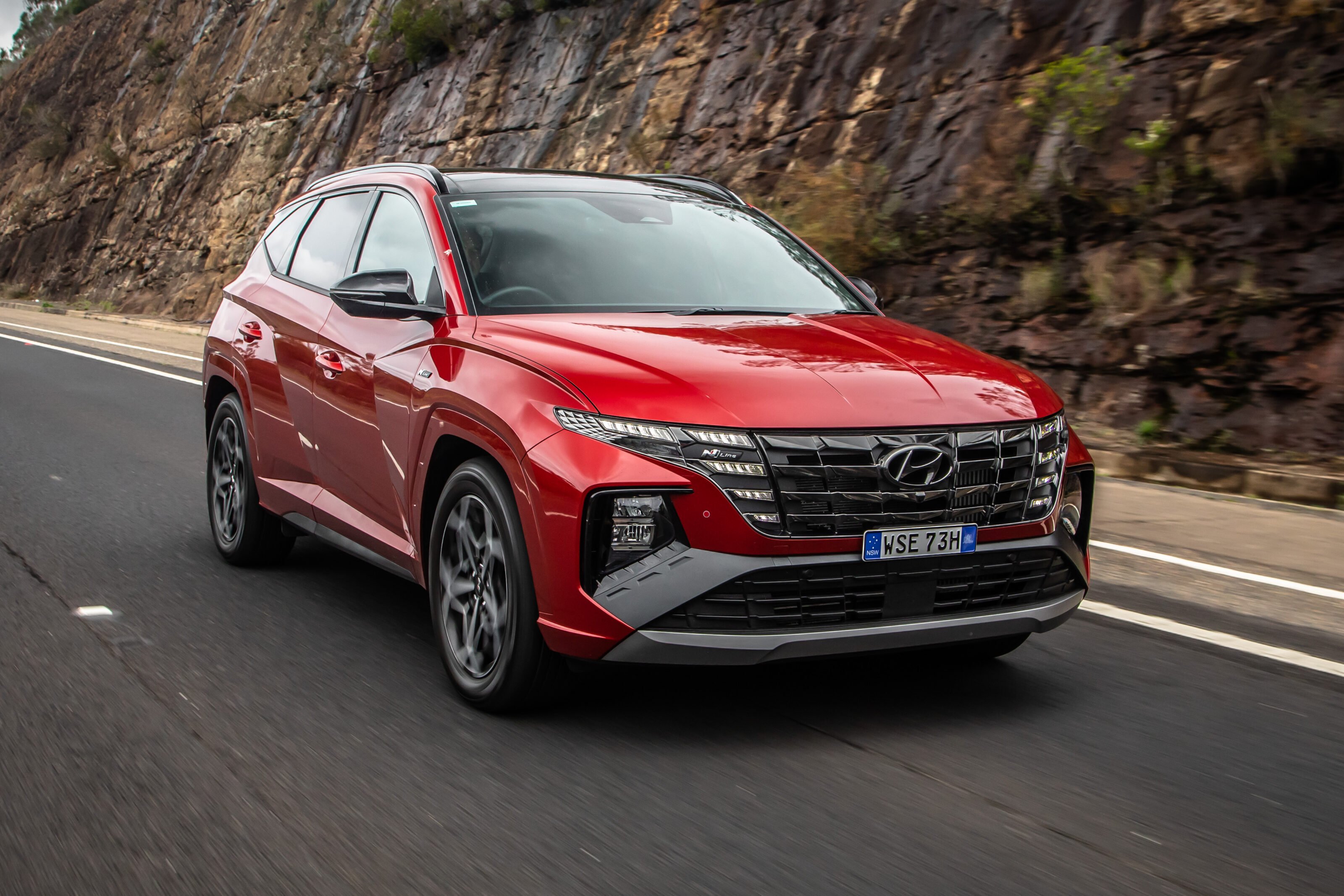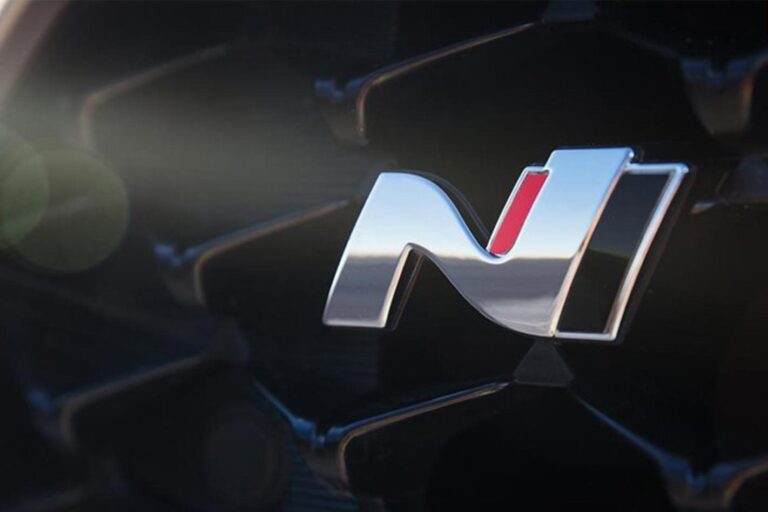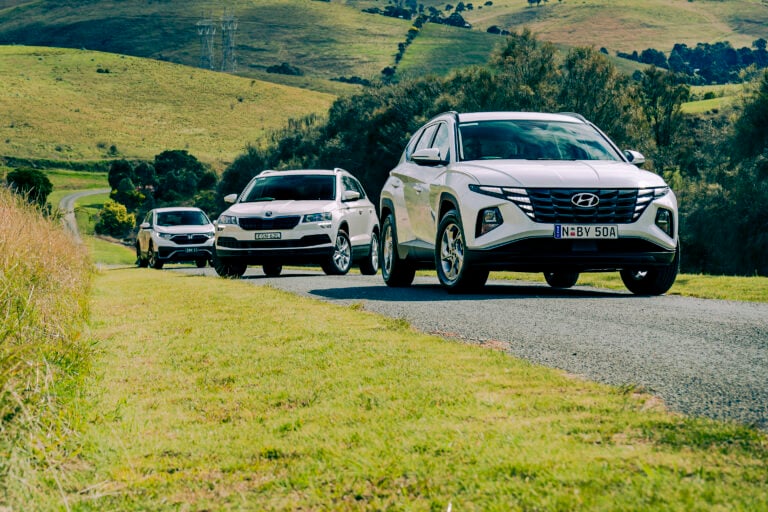Score breakdown
Things we like
- N-Line aesthetics
- Highlander loaded with features
- Interior space
- Rear-seat comfort
Not so much
- Unremarkable performance
- Slow-witted dual-clutch auto
- Unresolved damping
- Lane-keep system can be intrusive
We like to believe a Hyundai Tucson N is in the works at the company’s Namyang proving ground in South Korea, preparing to take on VW’s upcoming Tiguan R.
It may happen but remains in our imaginations for now – as does a dedicated N-Line version.
Contrary to expectations – based on initial Hyundai information, to be fair – the Tucson’s N-Line treatment arrives not as a specific trim grade but rather as an option pack available for all models.
N-Line versions of the i30 hatch, i30 sedan and Kona are all paired exclusively with a 1.6-litre turbocharged petrol engine and benefit from more advanced suspension set-ups. Even all-wheel drive in the case of the Kona.
The N-Line-flavoured aesthetics can be matched with the same engine in the Tucson, yet also a non-turbo 2.0-litre petrol or 2.0-litre turbo-diesel.
November 21, 2023: New-look 2024 Tucson revealed
Hyundai’s top-selling vehicle updated with Santa Cruz-like front end, plus a new-look dashboard inspired by the Kona and Santa Fe
Story continues: 2022 Tucson Highlander N-Line review
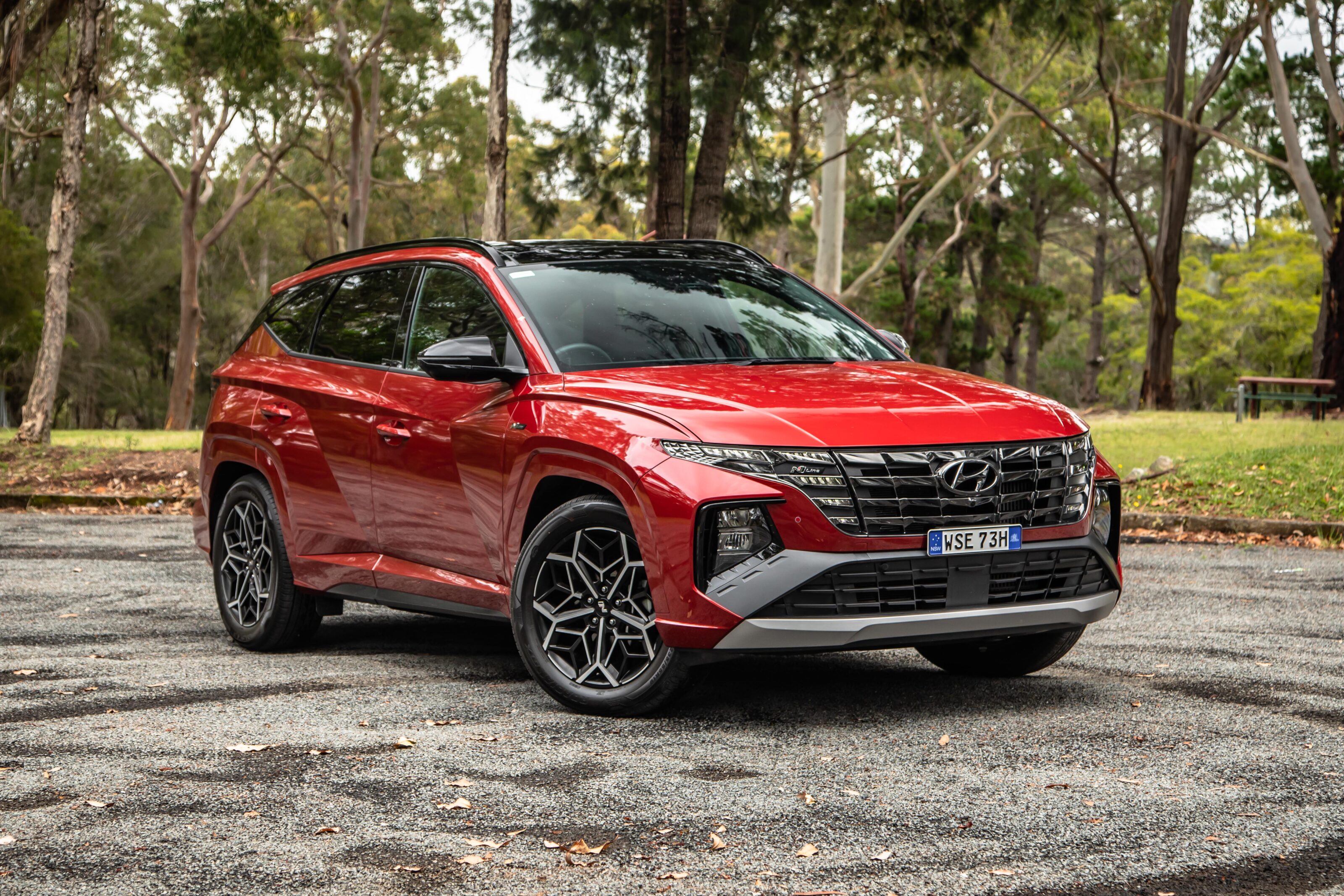
Pricing and Features
N-Line addendums are quite extensive for an outlay that ranges between $1000 and $3500 depending on trim grade.
The pack is more expensive for base and Elite Tucsons, where it adds LED headlights and tail-lights, 19-inch wheels, 10-inch digital driver display and auto high beam. The base model also gains LED indicators for the side mirrors.
All this is standard on the regular, $50,000 (plus on-road costs) Highlander, as are the bigger wheels – so the range-topper simply adopts the different N-badged rims if you tick the $1000 N-Line option.
The sportier embellishments tie in completely naturally with the bolder, more aggressive design of the latest Tucson
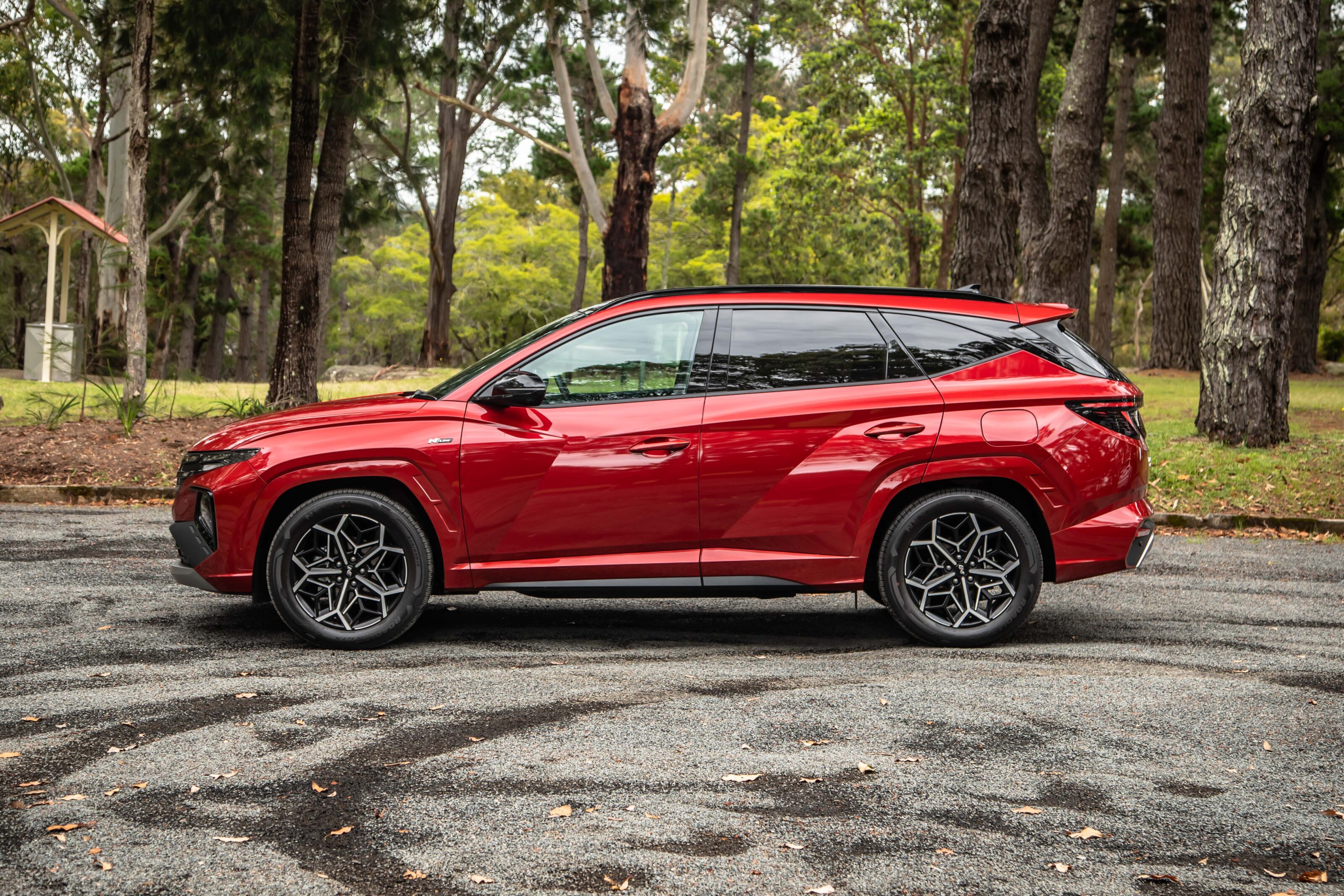
Elsewhere for the exterior N-Line treatment, the front end adopts a gloss effect for the dark chrome grille, there’s a deeper-chinned bumper and a black surround for the LED headlights. At the rear, there’s a revised design for the bumper, skid plate and roof spoiler.
Lower cladding swaps from black to body colour, then there’s the rather fetching Crimson Red only available with the N-Line pack and applied to our Highlander test vehicle.
The sportier embellishments tie in completely naturally with the bolder, more aggressive design of the latest Tucson.
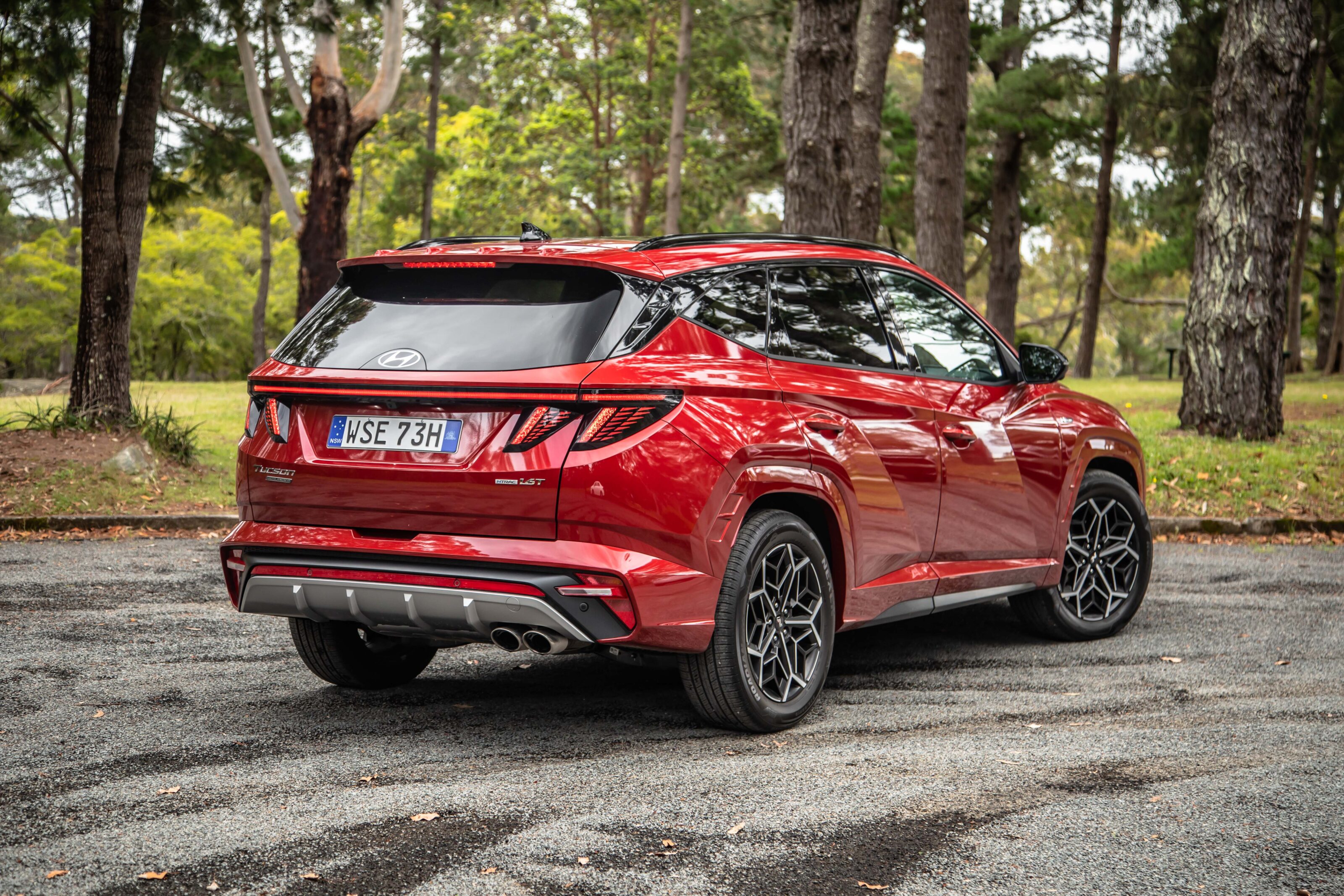
N-Line touches are obvious inside, too – most notably the highly tactile upholstery that combines suede cushions and seatbacks with leather-appointed bolstering. There’s a plastic N badge for the front seats.
There’s also the almost obligatory red stitching and an N-logo steering wheel with perforated grips borrowed from the Sonata N-Line.
Front-drive Tucsons again an N-Line gear knob as they have a regular lever where AWDs have a rotary controller.
As otherwise a Highlander model, this Tucson is heavily specced.
Comfort and Space
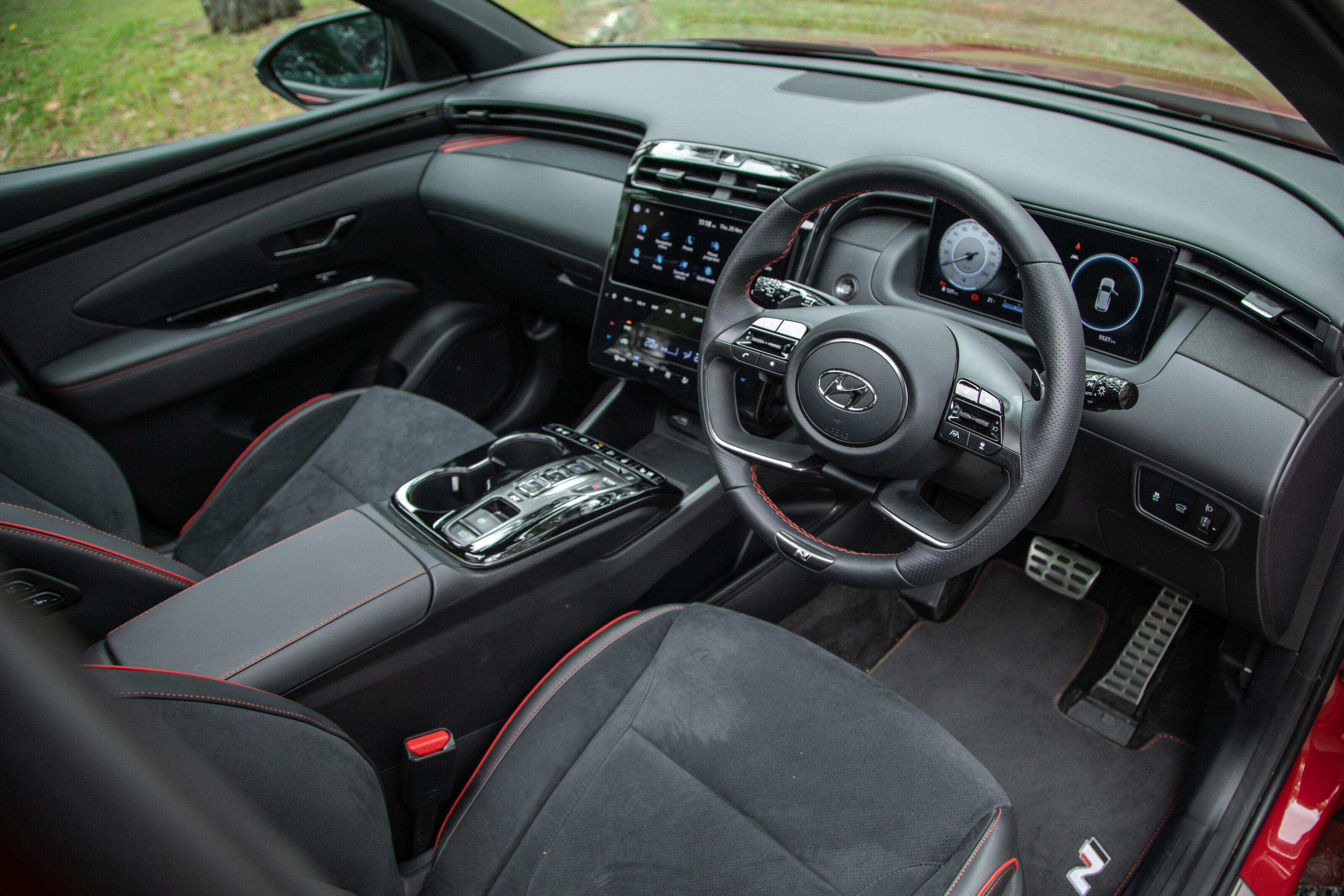
The sportier N-Line theme doesn’t upset the upmarket nature of the Tucson’s cabin, which combines tangible material quality with smart design elements – such as the continuous vent strips that blend into the central, square infotainment/HVAC dash console.
Where there are cheaper plastics, they’re slightly better disguised than they are in its twin-under-the-skin Kia Sportage GT-Line.
The fabric trim applied to parts of the dash and doors is reminiscent of the soft-touch material introduced on the Holden VF Commodore.
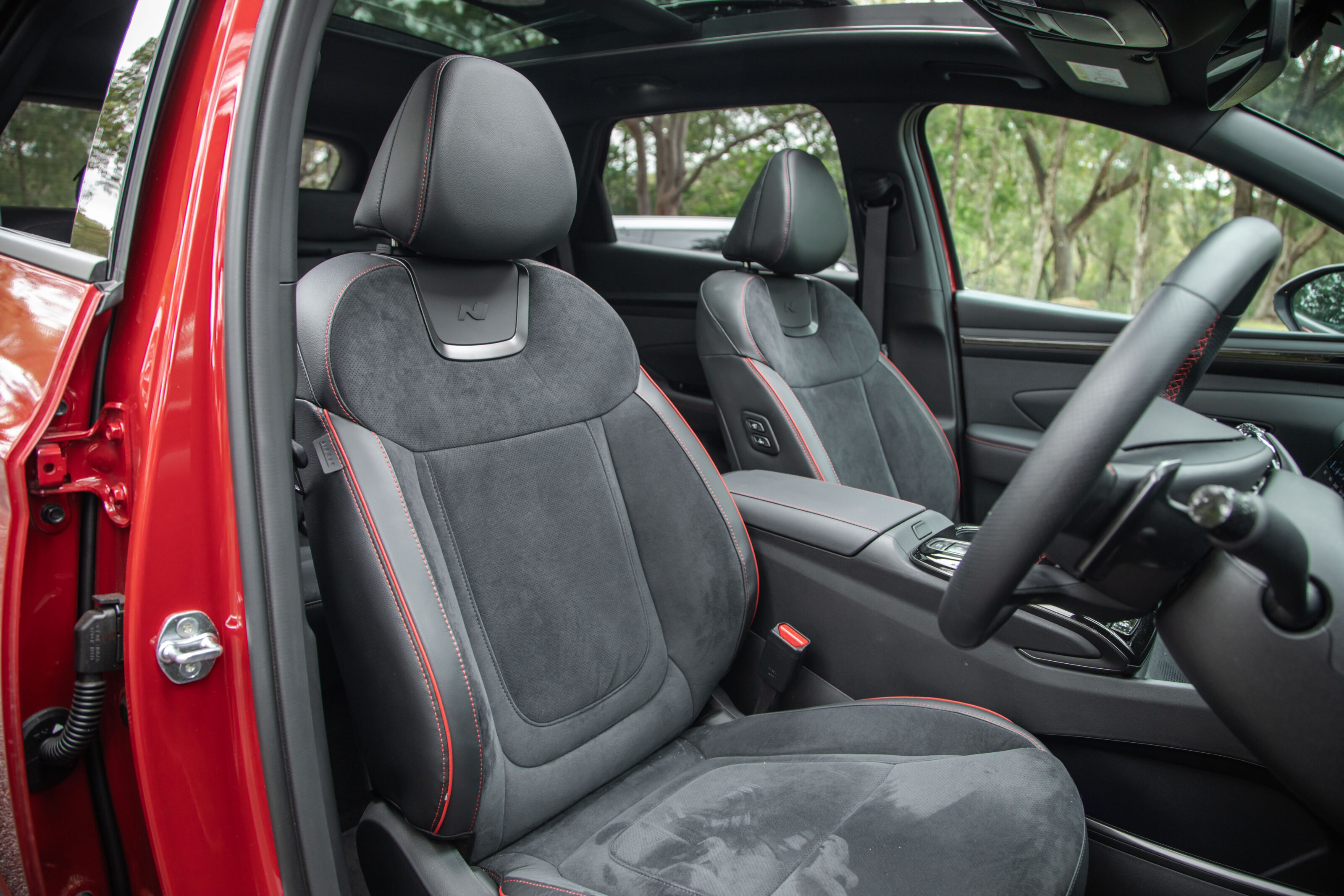
As with the Sportage, some longer-legged occupants may find the front-seat cushions shorter than ideal for longer trips. Limited seat-height travel also doesn’t allow for the lower position that some might prefer.
We found the front seats of the new Mitsubishi Outlander Exceed, which happened to be along for some photography, more comfortable generally, including much better under-thigh support.
There’s a good level of storage up front, including door cubbies that are better sized for bottles than those in the Sportage. One-touch windows feature front and rear, too, where they’re limited to the fronts on the Sportage GT-Line.
The sportier N-Line theme doesn’t upset the upmarket nature of the Tucson’s cabin, which combines with tangible material quality with smart design elements

The Highlander is the only trim grade where inductive smartphone charging is included. Its cabin also adds ventilation to the front seats (also heated from Elite upwards), position memory settings for the driver’s seat, heated steering wheel, auto-dimming rearview mirror, panoramic roof, and a fine-sounding Bose audio system.
A 10-inch centre touchscreen serves up an infotainment interface that takes little time to learn, has tidy visuals, and is responsive.
Maturely designed graphics are also presented in the driver display, which incorporates secondary blind spot assistance via a camera feed when indicators are used.

There’s no option to customise the layout, as with some rival driver displays such as the VW Tiguan’s Digital Cockpit – which includes the ability to feature a nav map so the central infotainment system can be used for other functions.
You also lose the digital speedo if you want other driving information in the central section of the display, not helped by the lack of a head-up display.
The Tucson’s significant size increase for this generation may lose the compact footprint but the benefit is significantly more rear legroom. The Highlander’s pano-roof doesn’t come at the expense of head clearance, either.
Its angled and scalloped bench, plus ventilation, ensures comfort isn’t supplied only by space.
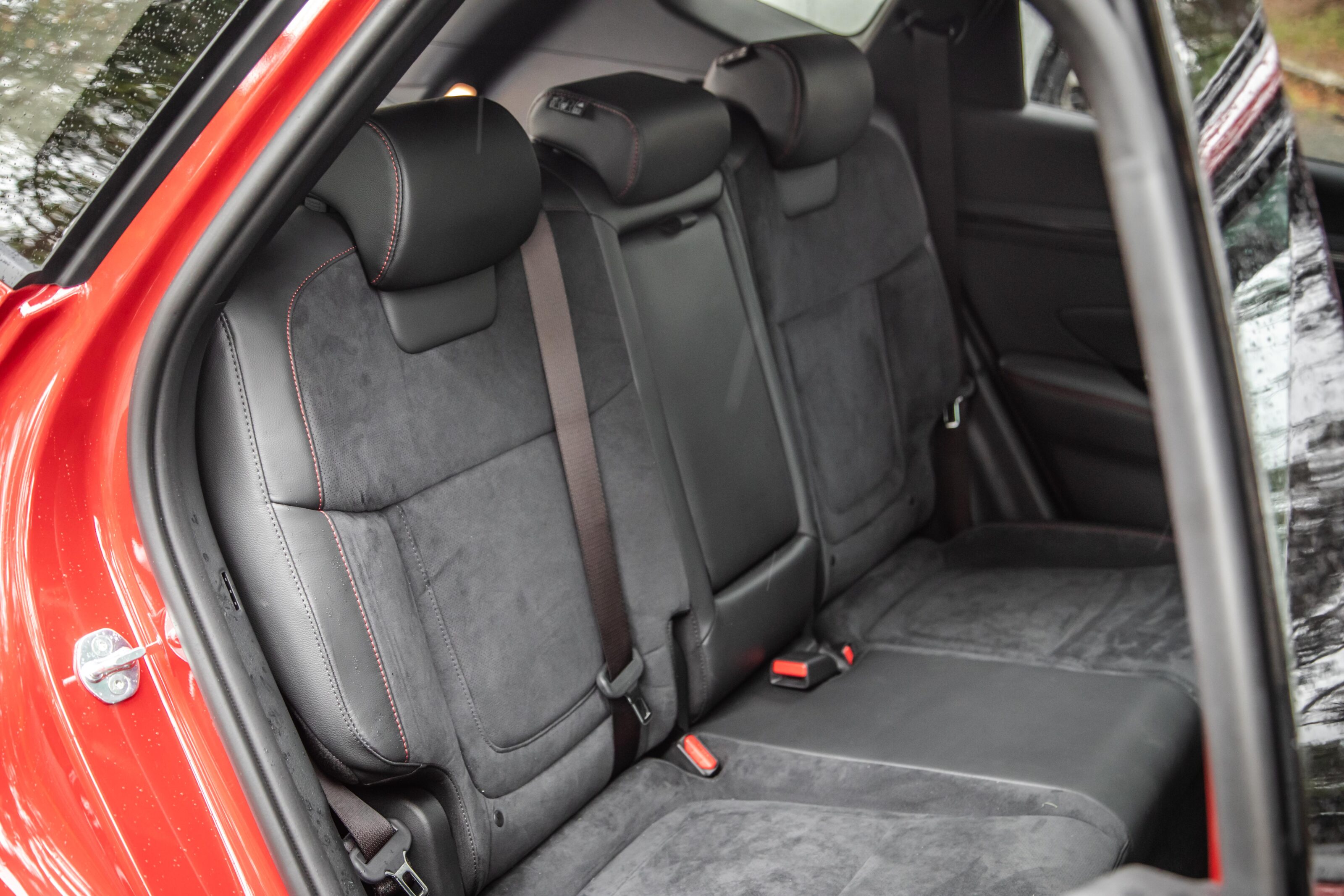
It has plentiful storage options, too, with dedicated bottle holders in the doors, net pouches, and a fold-down centre armrest with cup holders. Unusually, the Tucson goes with dual USB-A sockets where its Kia equivalent features USB-C ports.
Highlander spec provides an auto tailgate that will open if you stand in front of it for a few seconds with the keyfob on your person.
That accesses a large boot complete with full-size spare wheel under the floor and release levers for folding the 60:40 split seatbacks.
On the Road

All Tucson models come with a long list of driver aids, including useful features such as speed limit notification, adaptive cruise control and an alert that lets you know when a stationary car ahead has moved off.
Less helpful sometimes is the lane-keep system, which activates above 60km/h and has a habit of interfering unnecessarily with the steering. It can be switched off by holding a button on the steering wheel but is on as a default setting.
When off, the steering is easier to appreciate for its effortless and predictable responses throughout its arc.

The Tucson’s suspension wasn’t treated to the usual extensive tuning by Hyundai Australia’s local engineering team, and it is telling, if not leading to a deal-breaking situation.
While Hyundai’s mid-size SUV cushions occupants nicely from nasty potholes, the damping is less effective at isolating the cabin from small- to medium-size bumps or road joints. The Tucson can feel particularly busy on country roads.
It’s here, however, where the Hyundai’s well-sorted handling can be savoured.
The suspension wasn’t treated to the usual extensive tuning by Hyundai Australia’s local engineering team, and it is telling, if not leading to a deal-breaking situation

For all the changes for the fourth-generation Tucson, none were under the bonnet. A 2.0-litre petrol remains the sole choice for the base model, while Elite and Highlander are also available with a 1.6-litre turbo-petrol or 2.0-litre diesel.
The turbocharged four-cylinder petrol seems a natural pairing for a model wearing an N-Line badge.
Installed in a circa-1700kg Tucson that’s much heavier than an i30 N-Line hatch with the same engine, however, this SUV can’t replicate the hatch’s spirited performance.
At 265Nm, the maximum torque feels about 100Nm down from where it needs to be.
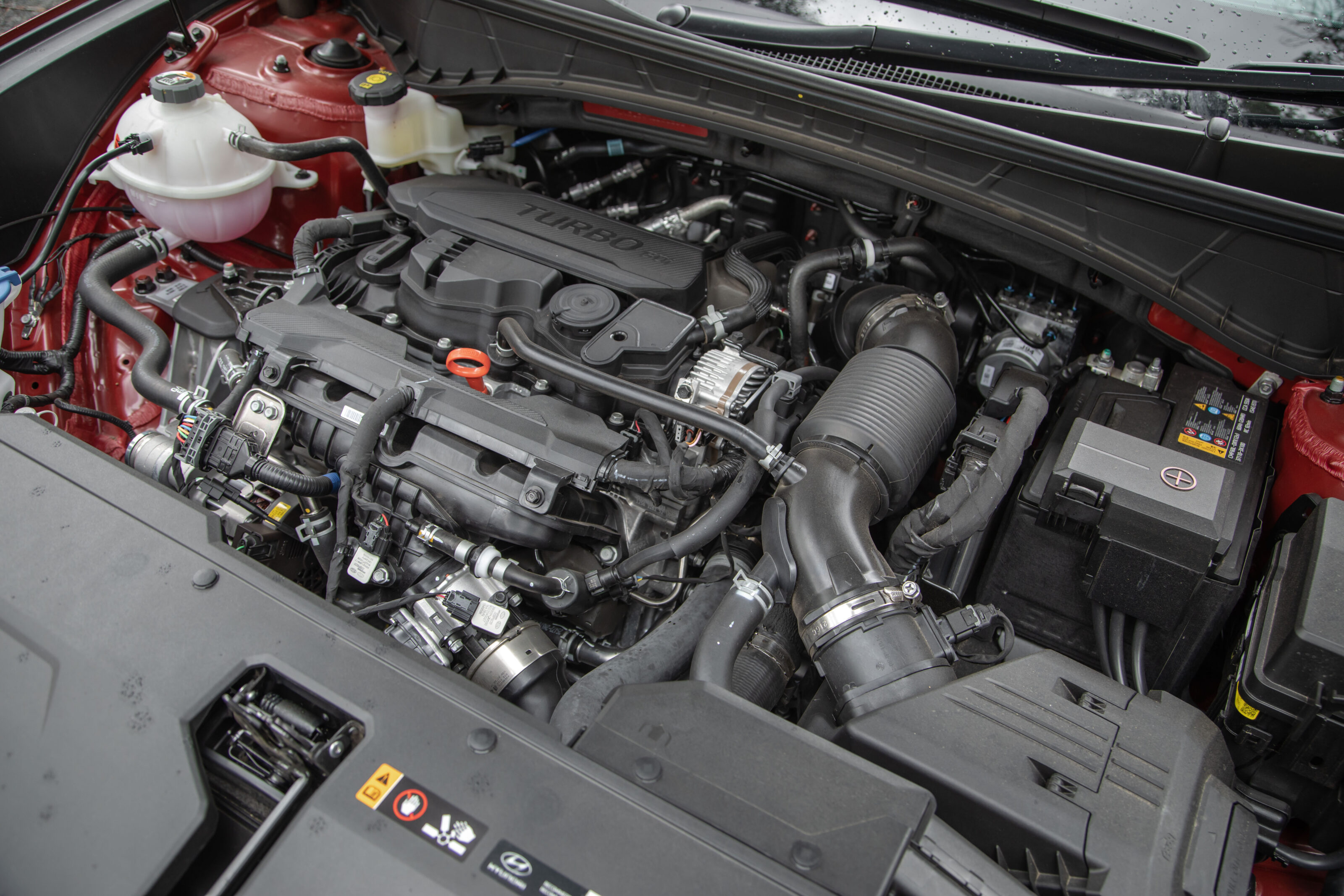
Several direct rivals serve up more punch for similar money, such as VW’s Tiguan 162TSI (162kW/350Nm) and Mazda’s CX-5 GT Turbo (170kW/420Nm). Or there’s the Ford Escape ST-Line AWD with outputs of 183kW and 387Nm for just $40,990 before on-road costs.
Hyundai does have a 213kW/422Nm 2.5-litre turbo petrol – fitted to the front-drive Sonata N-Line – and that model’s eight-speed dual-clutch auto would likely also be preferable to the seven-speed version fitted to the Tucson.
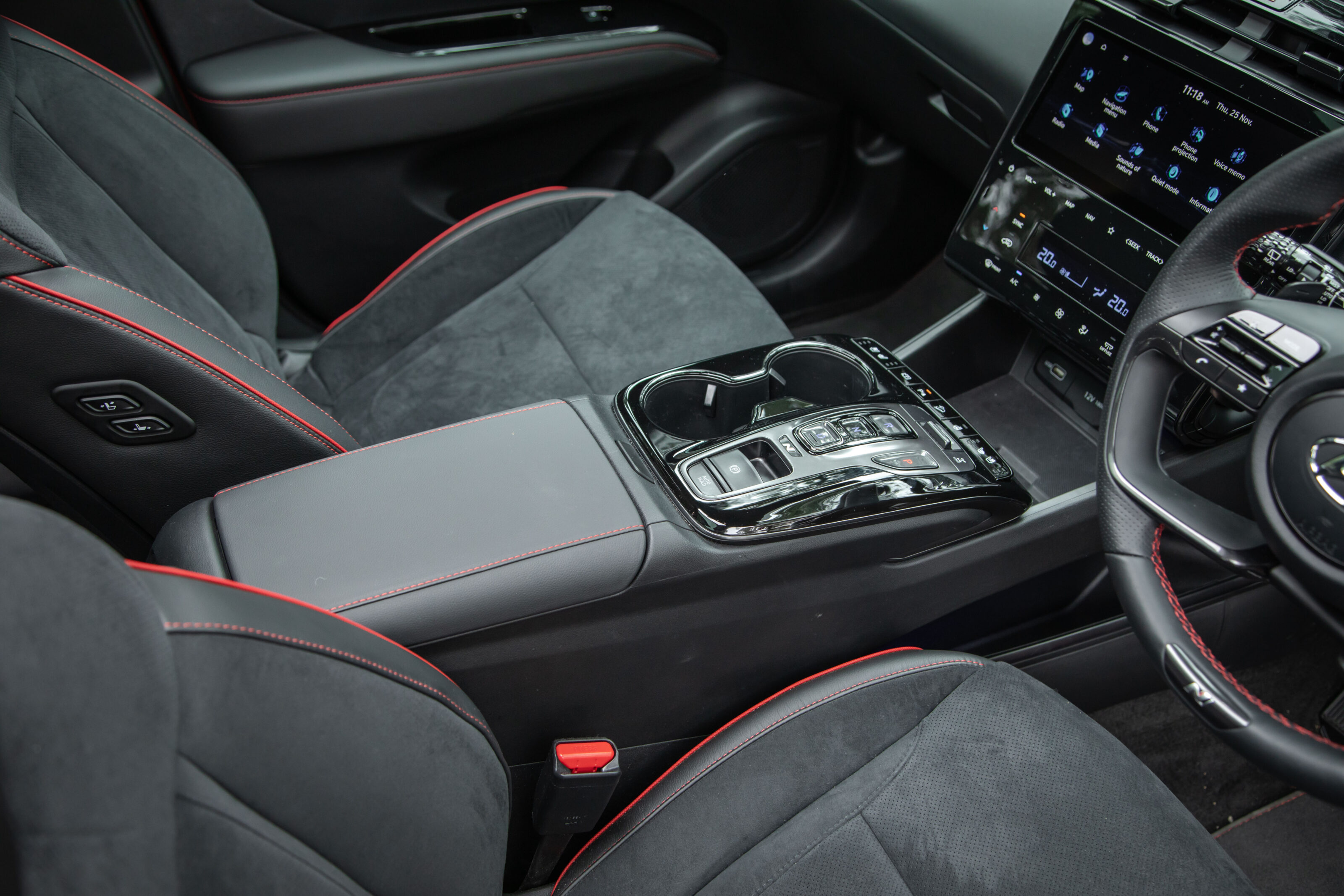
Slow at responding to increased throttle pressure, the seven-speed transmission can occasionally cause rev flare as it startles awake, while it’s slower at changing gears than is usual for this type of transmission, which pre-engages the next ratio.
The pick of the engines remains the diesel that offers both stronger pulling power and better efficiency. It’s a good return for just an extra $2100-odd in drive-away pricing.
Official fuel consumption for the turbo-petrol Tucson is 7.2L/100km, with 91 RON acceptable. Our trip computer indicated as high as 14.1L/100km during some suburban running, and down in the nines during testing that included some freeway and country roads.
Ownership

The Tucson comes with a five-year warranty. Service intervals are shorter for the turbo-petrol compared with the regular petrol or diesel – every 10,000km rather than 15,000km.
Each upkeep visit costs $319 for the first five years, peaking at $640 at the seventh before becoming cheaper again.
Service costs are slightly more expensive for the diesel.
Verdict

Choosing the N-Line option is more a question of styling preference than financial consideration – even more so for the Highlander. It doesn’t alter the Tucson’s status as a thoroughly modern and practical mid-size family SUV that’s just missing some suspension refinement and a convincing petrol engine.
We’d still like to see a proper, dedicated N-Line variant with something more potent in the engine bay, regardless of any potential future full-fat N model.
2022 Hyundai Tucson Highlander N-Line 1.6T specification
| Body | five-door medium SUV |
|---|---|
| Drive | on-demand AWD |
| Engine | 1.6-litre turbocharged 4cyl petrol |
| Transmission | 7-speed dual-clutch auto |
| Power | 132kW @ 5000rpm |
| Torque | 265Nm @ 1500-4500rpm |
| Bore stroke (mm) | 75.6 / 89.0 |
| Compression ratio | 10.5: 1 |
| 0-100km/h | Not available |
| Fuel consumption | 7.2L/100km (combined) |
| Weight | 1679kg |
| Suspension | front struts / rear multi-link |
| L/W/H | 4630mm/185mm/1665mm |
| Wheelbase | 2755mm |
| Brakes | 305mm ventilated disc front / 300mm solid disc rear |
| Tyres | Nexen Roadian GTX 235/55R19 |
| Wheels | 19-inch wheels (full-size spare) |
| Price | $51,000 plus on-road costs |
Score breakdown
Things we like
- N-Line aesthetics
- Highlander loaded with features
- Interior space
- Rear-seat comfort
Not so much
- Unremarkable performance
- Slow-witted dual-clutch auto
- Unresolved damping
- Lane-keep system can be intrusive


